Belgium 2015 "The fearsome Dinosaurs"
| <prev | back to index | next> |
| Issue Date | 07.09.2015 |
| ID | Michel: 4595-4604, Scott: 2768-2777, Stanley Gibbons: SB184, Yvert et Tellier: C4519, Category: pR |
| Designer | Design: Conz (Constantijn van Cauwenberge), Layout: Myriam Voz |
| Stamps in set | 10 |
| Values | Domestic letter rate of letters up to 50gr. = Euro 0.72 Prehistoric animals on stamps: Giraffatitan Torovosaurus Olorotitan Deinonychus Aurornis Ankylosaurus Einiosaurus Pteranodon Iguanodon Kentrosaurus |
| Emission/Type | commemorative |
| Issue place | Brussels |
| Size (width x height) | 30mm x 25 mm; Booklet: 60mm x 163,4mm |
| Layout | Sheets of 10 self-adhesive stamps |
| Products | FDS (First Day Sheet) x1 |
| Paper | polyvalent white |
| Perforation | die-cut 10 |
| Print Technique | Offset lithography |
| Printed by | Stamps Production Belgium |
| Quantity | 113.924 booklets |
| Issuing Authority | La Poste De Post Belgique |
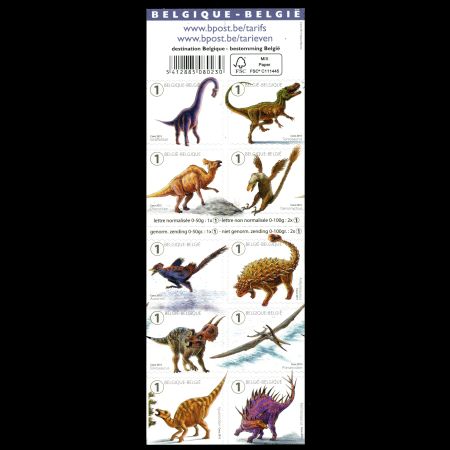
The first time Belgium released a dinosaur stamp was in 1966 for a set in honor of Belgium's Museums which issued a stamp depicting Iguanodon in a set of 7 stamps. On September 7th 2015, nearly 50 years later, Belgium released a new set of self-adhesive stamps depicting 9 dinosaurs and a pterosaur (flying reptile).
All stamps have the same domestic rate. One stamp can be used to pay a letter of the weight up to 50 gr. Two stamps are enough to pay a postage of a letter up to 100 gr.
These stamps were designed by Belgian cartoonist/designer Conz – the pseudonym of Constantijn van Cauwenberghe.
Contantijn Van Cauwenberghe, who signs his work Conz, studied at the Saint Luc Institute in Brussels,
where he graduated in animation and graphic design, with a specialization in comics. He published his semi-autobiographical work
in the magazine INK, published by Oogachtend.
He made his album debut in 2004 with 'Toen Ik Nog Baas Van De Wereld Was', a story about his
childhood in Louven.
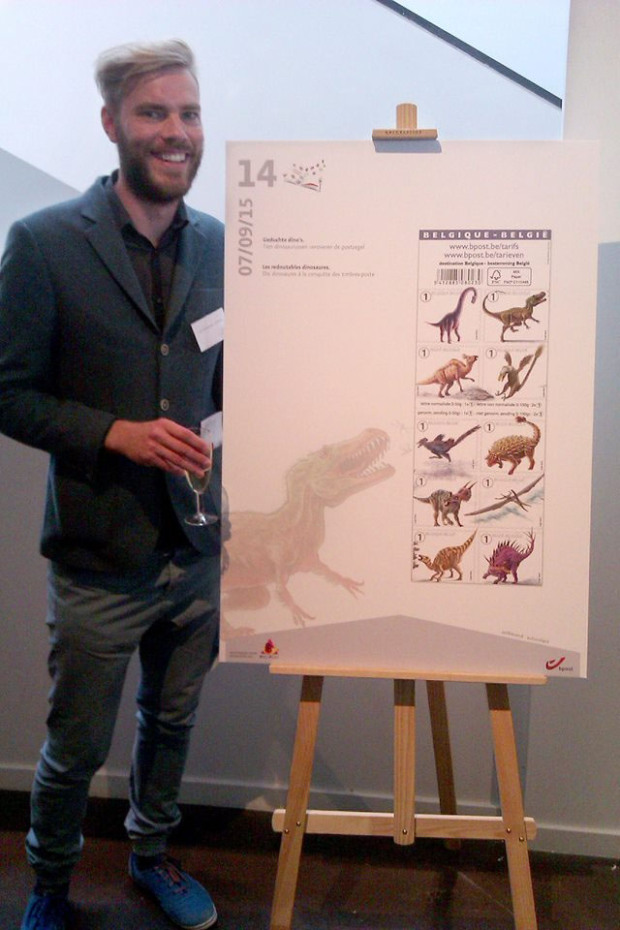
|
| Constantijn van Cauwenberghe, the stamps designer, presents his work. |
He became the city's artist of Turnhout in 2006 and in that year, he wrote the silent comic
'De Slag om Turnhout'.
Between 2005 and 2007 he published the romantic trilogy 'De Tweede Kus', also with Oogachtend.
The "Conz" tried to select dinosaurs that have some link with Belgium, such as: the famous Bernissart's Iguanodon (discovered in a Belgian coal mine between 1878 and 1881), Olorotitan and Aurornis were studied and described by Belgian scientist Pascal Godefroit, etc.
In other cases, he tried not to use the more commonly-known species, such as Tyrannosaurus Rex, Triceratops, or Stegosaurus, but rather their lesser-known cousins such as the Torvosaurus, the Einiosaurus and Kentrosaurus.
He explained:
“Bpost came to me to make this stamp series, probably because I had previously illustrated dinosaurs in comics.
After creating a plan I made a selection of ten animals, which were a diverse mix of different types.
As a base I used skeletal reconstructions. Then I did some research and also used my imagination to create ‘realistic’ muscle and fat mass to fit each animal – adding skin, feathers and hair where appropriate. Due to lack of evidence, the colours are of course entirely speculative. I’ve chosen striking colours so that the stamps would stand out a bit. For colour patterns I have gained inspiration from savannah animals and many birds.
I wanted to avoid the 'monstrosity' classic dinosaurs. After all, these are species that have lived and gone there long, long time.”
Conz submitted his drafts to paleontologists of the Museum of Natural Sciences in Brussels, so that they comply as much as possible the proportions and the attitude of each dinosaur.
Giraffatitan (sauropod, long neck, very big, herbivore, family Brachiosaurus)

Sketch of Giraffatitan stamp of Belgium 2015. Image credit: The Ephemerist (blog of "Conz" - does not exist anymore)
Giraffatitan, meaning "titanic giraffe", is a genus of sauropod dinosaur that lived during the late Jurassic Period (Kimmeridgian-Tithonian stages).
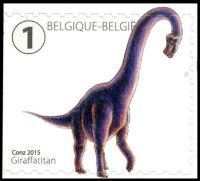 |
| Giraffatitan stamp of Belgium 2015, MiNr: 4595, Scott: 2768. |
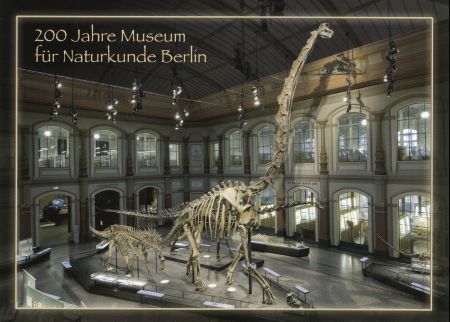 |
| Giraffatitan on postcard of Germany 2010. |
A famous specimen of Giraffatitan brancai mounted in the Museum für Naturkunde (Berlin, Germany) is one of the largest, and in fact the tallest, mounted skeletons in the world, as certified by the Guinness Book of Records.
Giraffatitan brancai was first named and described by German paleontologist Werner Janensch in 1914 as Brachiosaurus brancai, based on several specimens recovered between 1909 and 1912 from the Tendaguru formation of German East Africa.
German East Africa was, of course, a German colony between 1885 and 1919, when it was broken up among Britain and Belgium under the Treaty of Versailles, today Tanzania.
It is known from five partial skeletons, including three skulls and numerous fragmentary remains including skull material, some limb bones, vertebrae and teeth. It lived from 145 to 150 million years ago, during the Kimmeridgian to Tithonian ages of the Late Jurassic period.
Torovosaurus (meat eater, appointed by a Belgian paleontologist, family of T-rex)

Sketch of Torovosaurus stamp of Belgium 2015. Image credit: The Ephemerist (blog of "Conz" - does not exist anymore )
The bones of the Torvosaurus gurneyi or "the ferocious lizard Gurney" (named in honor of the famous American paleoartist James Gurney – creator of the utopic world of Dinotopia, who also designed dinosaur stamps for USA in 1997 and Australia 2013), were found a few years ago into a cliff near Portuguese da Praia Vermelha, near of Lisbon.
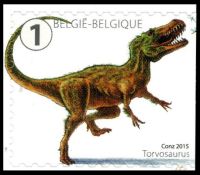 |
| Torvosaurus gurneyi stamp of Belgium 2015, MiNr: 4596, Scott: 2769. |
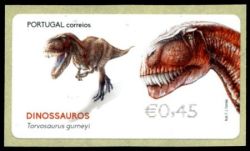
|
| Torvosaurus gurneyi on ATM stamp of Portugal 2015, MiNr: 4596, Scott: 2769. |
A Dutchman found the bones, but it was the Belgian paleontologist, Dr. Christophe Hendrickx, during his dissertation work at the New University of Lisbon who described the bones and realized that they represented a new species. At first it was thought that it was Torvosaurus tanneri, a carnivore that lived in North America. However, detailed examination by Dr. Hendrickx showed that it was a different kind.
The Torvosaurus gurneyi lived in Portugal, Spain, France and Andorra and has a lot of similarities with the Tyrannosaurus rex. Like the famous T-rex, Torvosaurus had the short arms, razor-sharp teeth of about ten centimetres long and he used his claws to tear its prey apart.
The two carnivores, however, never met each other. Torvosaurus gurneyi lived in the late Jurassic, about 150 million years ago.
He was probably the biggest meat eater who walked, because the bigger Tyrannosaurus rex came only in the Cretaceous, some 70 million years ago. At that time the Torvosaurus had been extinct for a long time.
Olorotitan (herbivore, Belgian discovery in Russia)

Sketch of Olorotitan stamp of Belgium 2015. Image credit: The Ephemerist (blog of "Conz")
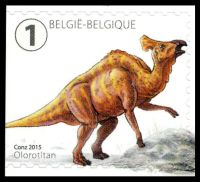 |
| Olorotitan stamp of Belgium 2015, MiNr: 4597, Scott: 2770. |
The type, and only species is Olorotitan arharensis whose holotype specimen, consisting of a nearly complete skeleton, was described by Belgian scientist Pascal Godefroit (director of Earth and Life Sciences at the Royal Belgian Institute of Natural Sciences) in mid-2003. The generic name Olorotitan means "gigantic swan", while the specific descriptor arharensis refers to the location of the fossil find at Arhara County.
Olorotitan is distinct from other crested duckbills by its possession of an unusual crest that points backward and takes on a hatchet or fan-like shape. Its discovery has implications for the diversity of lambeosaurine hadrosaurids.
A skeleton of an Olorotitan is on the display in the Dinosaur Gallery of the Museum of Natural Sciences in Brussels
Deinonychus (Theropodia, carnivore, Velociraptor family)

Sketch of Deinonychus stamp of Belgium 2015. Image credit: The Ephemerist (blog of "Conz")
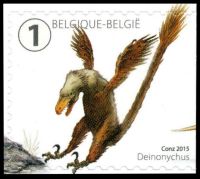
|
| Deinonychus stamp of Belgium 2015, MiNr: 4598, Scott: 2771 |
The species name antirrhopus means "counterbalance". These extensions of the tail vertebrae were ideal for helping the animal maintain balance as it ran or attacked prey.
"Terrible claw" refers to the unusually large, sickle-shaped talon on the second toe of each foot.
This species, which could grow up to around 3.4 meters long, lived during the Early Cretaceous (about 115–108 million years ago) from the mid Aptian to early Albian ages. Fossils have been recovered from the U.S. states of Montana, Utah, Wyoming, and Oklahoma (in rocks from the Cloverly Formation and Antlers Formation), though teeth possibly belonging to Deinonychus have also been found much farther east in the state of Maryland.
Deinonychus was the model for the “raptor” dinosaurs of the motion picture Jurassic Park (1993).
Aurornis (feathered dinosaur, named by a Belgian)

Sketch of Aurornis stamp of Belgium 2015. Image credit: The Ephemerist (blog of "Conz")
Aurornis is an extinct genus of theropod dinosaurs from the Jurassic period of China. The genus Aurornis contains a single known species Aurornis xui - may be the most basal ("primitive") avialan dinosaur known to date, and it is and it is one earliest avialans known. Aurornis was roughly the size of a modern pheasant, with a length of 50 cm.
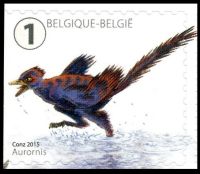 |
| Aurornis stamp of Belgium 2015, MiNr: 4559, Scott: 2772. |
Aurornis was described from a fossil in a sedimentary rock in 2013. The fossil was purchased from a local dealer who said it had been unearthed at Yaoluguo in western Liaoning, China. Subsequent analysis confirmed it came from the Tiaojishan Formation, which has been dated to the late Jurassic period (Oxfordian stage), approximately 160 million years ago.
The fossil features traces of downy feathers along the animal's tail, chest, and neck. It was only partially prepared at the time of purchase with the feathers not showing and bore no signs of forgery.
On 7 June 2013, Science Magazine published an article which noted that Pascal Godefroit (Belgian scentist), the paleontologist who led the team that described Aurornis, reported that he is uncertain if the fossil material came from Liaoning province's 160-million-year-old Tiaojishan Formation, as the information provided by the fossil dealer indicated, or from the province's 125-million-year-old Yixian Formation, which is known to have produced several ancient bird fossils. The failure to secure rigorous provenance information casts doubt on the claim that Aurornis is 160 million years old and predates Archaeopteryx.
Godefroit's team will attempt to confirm the specimen's provenance, and its age, by conducting mineralogical and botanical analysis on the slab of shale and then publishing their findings.
Ankylosaurus (ankylosauridae, herbivore, completely armored, full of thorns and a club on the tail)

Sketch of Ankylosaurus stamp of Belgium 2015. Image credit: The Ephemerist (blog of "Conz")
Ankylosaurus is a genus of thyreophoran dinosaur. Fossils of Ankylosaurus have been found in geologic formations dating to the very end of the Cretaceous Period, between about 68–66 million years ago, in western North America, making it among the last of the non-avian dinosaurs.
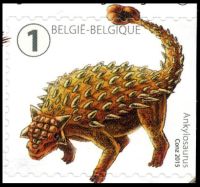
|
| Ankylosaurus stamp of Belgium 2015, MiNr: 4600, Scott: 2773. |
The largest known ankylosaurid, Ankylosaurus measured up to 6.25 meters in length, 1.7 meter in height, and weighed 6 tonnes. It was a quadrupedal animal, with a broad, robust body. It had a wide, low skull, with two horns pointing backwards from the back of the head, and two horns below these that pointed backwards and down. The front part of the jaws were covered in a beak, with rows of small, leaf-shaped teeth further behind it. It was covered in armour plates, or osteoderms, with bony half-rings covering the neck, and had a large club on the end of its tail. Bones in the skull and other parts of the body were fused, increasing their strength, and this feature is the source of the genus name.
A skeleton of an Ankylosaurus is on the display in the Dinosaur Gallery of the Museum of Natural Sciences in Brussels
Einiosaurus (Ceratopsia, horned dinosaur, herbivore, family Triceratops)

Sketch of Einiosaurus stamp of Belgium 2015. Image credit: The Ephemerist (blog of "Conz")
The genus Einiosaurus contains only one species. Einiosaurus procurvicornis is a medium-sized herbivorous centrosaurine ceratopsian dinosaur from the Upper Cretaceous (Campanian stage) of north-western Montana, USA.
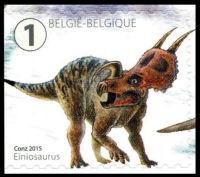 |
| Einiosaurus stamp of Belgium 2015, MiNr: 4601, Scott: 2774. |
Fossils of the dinosaur were discovered by American paleontologist Jack Horner in 1985 and excavated from 1985 to 1989 by Museum of the Rockies field crews.
Einiosaurus was a herbivorous dinosaur, with estimated the body length of 4.5 metres and weight at 1.3 tonnes.
The nasal horn has a base that is long from front to rear, is transversely flattened, and is strongly curved forwards in some adult specimens. The supraorbital "brow" horns as far as they are present are low and rounded with a convex surface on the inner side. The parietal parts of the rear edge of the skull frill together bear a single pair of large curved spikes sticking out to behind.
Einiosaurus lived in a climate that was seasonal, warm, and semi-arid. There is some evidence that Einiosaurus, were herding animals similar in behaviour to modern-day bison or wildebeest.
Pteranodon (pterosaur or flying reptile, not a dinosaur)

Sketch of Pteranodon stamp of Belgium 2015. Image credit: The Ephemerist (blog of "Conz")
Pteranodon is a genus of pterosaurs, not a dinosaur which included some of the largest known flying reptiles, with wingspans over 6 metres.
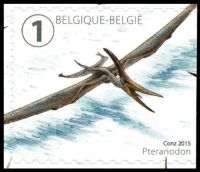
|
| Pteranodon stamp of Belgium 2015, MiNr: 4602, Scott: 2775. |
More fossil specimens of Pteranodon have been found than any other pterosaur, with about 1,200 specimens known to science, many of them well preserved with nearly complete skulls and articulated skeletons. It was an important part of the animal community in the Western Interior Seaway.
A crest at the back of the skull (a common feature among pterosaurs) may have functioned in species recognition; the crest of males was larger. The crest is often thought to have counterbalanced the jaws or have been necessary for steering in flight, but several pterosaurs had no crests at all.
The eyes were relatively large, and the animal may have relied heavily upon sight as it searched for food above the sea.
The design of Pteranodon’s jaws (toothless, very long and pelican-like ) and the discovery of fossilized fish bones and scales with Pteranodon specimens suggest that it was a fish eater. Paleontologists speculate that it may have skimmed the water while in flight, landed first to capture fish near the water’s surface, or dove after prey as modern diving birds do.
Nonetheless, Pteranodon is frequently featured in dinosaur books and is strongly associated with dinosaurs by the general public.
A skeleton of an Pteranodon is on the display in the Dinosaur Gallery of the Museum of Natural Sciences in Brussels
Iguanodon (herbivore dinosaur species, mounted skeletons of this animal are a point of pride of the Museum of Natural Sciences in Brussels);

Sketch of Iguanodon stamp of Belgium 2015. Image credit: The Ephemerist (blog of "Conz")
Iguanodon is a genus of ornithopod dinosaur that existed roughly halfway between the first of the swift bipedal hypsilophodontids of the mid-Jurassic and the duck-billed dinosaurs of the late Cretaceous.
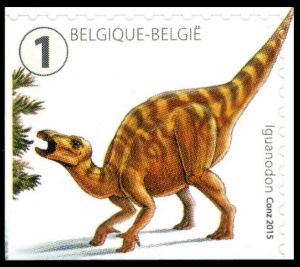 |
| Iguanodon stamp of Belgium 2015, MiNr: 4603, Scott: 2776. |
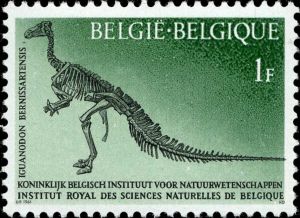 |
| Fossil of Iguanodon on stamp of Belgium from 1966 |
In 1878, dozens of Iguanodon skeletons were discovered in a coal mine in Bernissart, 322 m below the ground.
At the time, their proximity was considered proof that some dinosaurs were herd animals. They were mounted by Louis Dollo and set the standard that was followed for over a century. Nine of the twenty-nine skeletons are currently on display at the Royal Belgian Institute of Natural Sciences, and one at the Bernissart Museum. The two museums even made an error they acknowledge with humour: they displayed the skeletons "standing", suggesting that the dinosaurs were bipedal, which is not the case.
Iguanodon were large, bulky herbivores. Distinctive features include large thumb spikes, which were possibly used for defence against predators, combined with long prehensile fifth fingers able to forage for food.
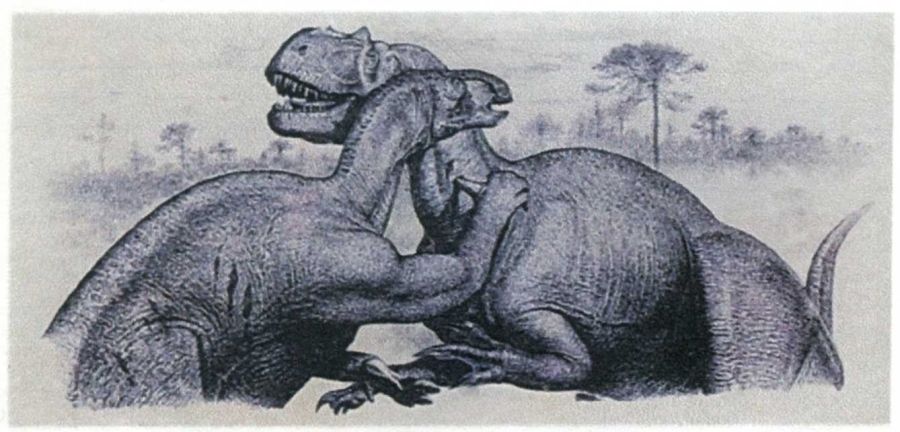
The genus was named in 1825 by English geologist Gideon Mantell, based on fossil specimens that are now assigned to different genera and species. Iguanodon was the second type of dinosaur formally named based on fossil specimens, after Megalosaurus. Together with Megalosaurus and Hylaeosaurus, it was one of the three genera originally used to define the Dinosauria by Sir Richard Owen in 1842.
Kentrosaurus (stegosauria, herbivore, family of the Stegosaurus, but with more spines on the back)

Sketch of Einiosaurus stamp of Belgium 2015. Image credit: The Ephemerist (blog of "Conz")
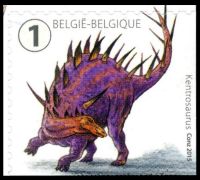
|
| Kentrosaurus stamp of Belgium 2015, MiNr: 4604, Scott: 2777. |
Often thought to be a "primitive" member of the Stegosauria, several recent cladistic analyses find it as more derived than many other stegosaurs, and a close relative of Stegosaurus from the North American Morrison Formation within the Stegosauridae.
Kentrosaurus was a small stegosaur with estimated body length around 4–4.5 metres, and weight about 700–1,600 kilograms. It walked on all fours with straight hindlimbs. It had a small, elongated head with a beak used to bite off plant material that would be digested in a large gut. It had a, probably double, row of small plates running down its neck and back. These plates gradually merged into spikes on the hip and tail. The longest spikes were on the tail end and were used to actively defend the animal. There also was a long spike on each shoulder. The thigh bones come in two different types, suggesting that one sex was larger and stouter than the other.
Products and associated philatelic items
| First Day Sheet | Examples of Circulates Covers | |
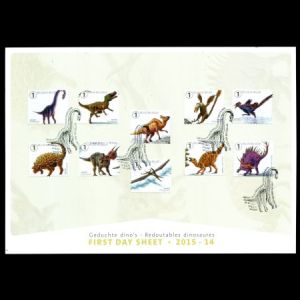 |
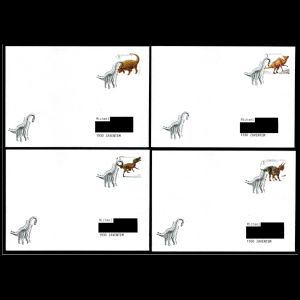 |
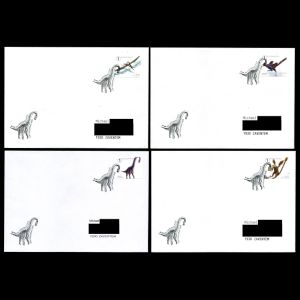 |
| The reverse side, contains short description and technical details: here | ||
| Special Postmark | First-Day-of-Issue Postmark | |
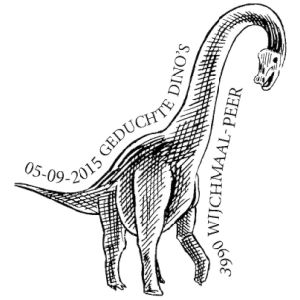 |
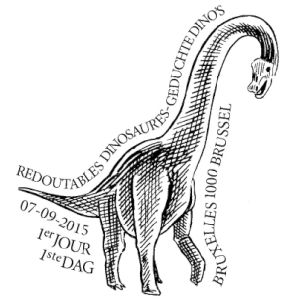 |
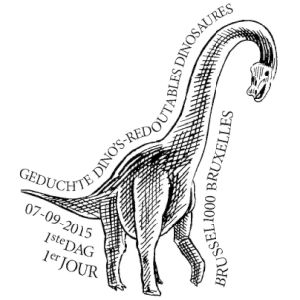 |
| Issued two days before the stamps issue: 05.09.2015 for the stamp presentation ceremony, with the text in Dutch. | Both postmarks were issued on the first day of issue and have the same design, but the text on the back of the Giraffatitan dinosaur is written on different languages: French versus Dutch. | |
| Examples of Circulates Covers | ||
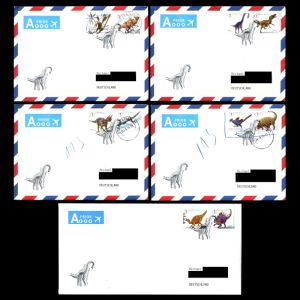 |
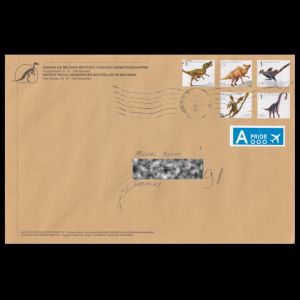 |
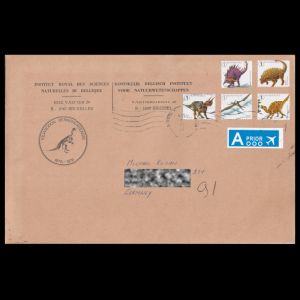 |
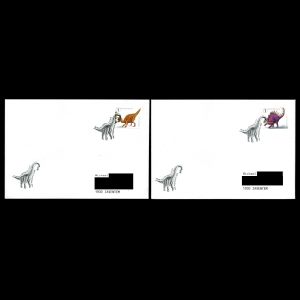 |
|
|
References

|
- Technical details and stamps release articles: Cartoonphilately, Freestampmagazine, Postzegelblog, Philandria.
- The stamp designer, Constantijn van Cauwenberge (Conz): Conzcomics, Sparehed.
- Ankylosaurus: Wikipedia.
- Aurornis: Wikipedia.
- Einiosaurus: Wikipedia.
- Deinonychus: Encyclopedia Britannica, Wikipedia.
- Giraffatitan: ExtinctMonsters. Wikipedia.
- Iguanodon: Royal Belgian Institute of Natural Science, Wikipedia.
- Kentrosaurus: Wikipedia.
- Olorotitan: Wikipedia.
- Pteranodon: Encyclopedia Britannica, Wikipedia.
- Torovosaurus: hendrickxchristophe, Wikipedia.
Acknowledgements
Many thanks to Dr. Peter Voice, PhD Department of Geological and Environmental Sciences, Western Michigan University, USA, for his help in finding information and for review of a draft of this article.| <prev | back to index | next> |